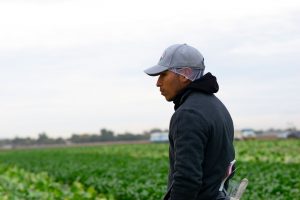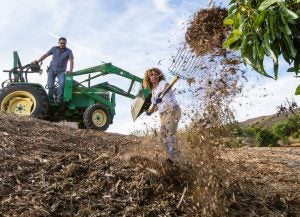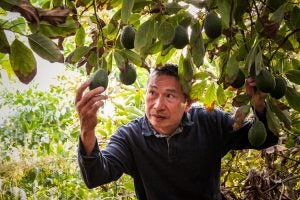California’s San Joaquin Valley may be the most prolific, ever diversifying, and life-bearing agriculture county in the country, but it hadn’t stopped Dr. Antonio Arreguin-Bermudez from realizing that immigrant laborers like himself couldn’t stay planted in the valley with their dreams for economic progress still stirring in their hearts.
Born in El Rodeo de San Antonio, Michoacán, Arreguin-Bermudez left Mexico after his middle school education to work in the fields of the San Joaquin Valley. But, his desire to pursue his passion for education had become too overwhelming to ignore. His sights never leaving his dreams, Arreguin-Bermudez applied for immigration amnesty — uprooting him from the fields and elevating him into the world of higher education.
Today, he is a positive influence and encourager to many students he teaches as a professor for the International Languages, Literatures, and Cultures Department at California State University of Chico.

Immigration amnesty is understood as the process of granting legal immigration status to folks without legal citizenship status. To understand the full nature of immigration amnesty and its influence on the United States and its people, let’s unpack its past, present, and future:
Past
“The American Dream”: A common phrase that rings throughout the world, advertising that, in the United States, anything that one imagines can come to fruition.
During the 19th century and into the early 1920s, folks from across the world invested in the promises this phrase insinuated, leaving their home countries to pursue greater economic prosperity. From 1880 to 1920, the United States received 20 million immigrants from predominately European and Asian countries. By 1930, 11.6 percent of the country’s population were foreign born and growing their new lives with an increased living income.
At that point in history, many leaders of the United States saw the increased immigration as a threat to the country’s economic security (i.e. foreign threats and overall job competition for its current citizens).
Thus, immigration policy was conceived, but not without pushback.
Early immigration policies enacted quota systems based on nationality; laws limiting the number of immigrants from their identified nationality from entering the country. With each policy enforced, labor groups such as the United Farm Workers Union began to take form; fighting back against these quota systems and offering compromises to federal policy.
One of those compromises was immigration amnesty.
Present
Currently, immigration amnesty laws are merely expanded versions of the Immigration Reform and Control Act (IRCA) of 1986. The IRCA influences many parts of immigration prior to its creation, but specifically influenced the country’s hiring process. The IRCA allows any employer to seek, hire, and recruit any person undocumented in the United States. This act and the reform that followed became a foot in the door for many immigrant laborers. Now, farm laborers can work, earn an income, and move slowly down a path of economic stability for themselves and their families; eventually being able to attain amnesty.
The battle for amnesty for farm laborers still continues, as many leaders on the federal level continue to draft legislation around immigration amnesty for it to then fail in a polarized Congress.
Future
However, one bill has yet to make its exit from the national stage. This bill, recently taken up by Congress, seeks to make the path to amnesty and overall citizenship easier to access for agricultural laborers.
Reintroduced to the congressional floor after dissipating in the Senate, the Farm Workforce Modernization Act (H.R. 1603) intends to create the country’s first-ever merit-based visa program specifically for the agriculture sector.
If passed, this bill would allow an immigrant farm laborer to attain certified agriculture worker status and provide a quicker pathway to citizenship for themselves and their families. Agriculture worker status wouldn’t be attained until the applicant has performed two years of agriculture labor (or 180 workdays during the two years preceding this act).
Once the applicant has spent four years in the agriculture worker status, the applicant can then go through the Earned Residency for Long Term Residence process.
While this process is occurring, the applicant may not be removed from the country unless deemed ineligible for the adjustment to their agriculture worker status.

Those who are against immigration amnesty, specifically as it relates to farm labor, oppose these new revisions to immigration reform, arguing that folks looking to receive legal status haven’t been abiding by United States laws of inhabiting the country from the beginning of their entering. Opponents make valid arguments, sharing frustrations that many bordering states have toward immigrants from Mexico that illegally make the trek across the border while damaging many farmers’ land in the process of migrating. Opponents also share that criminal activity of undocumented immigrants doesn’t end with their migration but travels with them into the country, where undocumented folks can engage in illegal activity to earn an income. Opponents believe that undocumented folks should not be rewarded for this behavior.
However, proponents to these revisions argue that many undocumented folks have lived in the states for a number of years and find value in integrating them into our systems (such as social security, taxes, etc.). Proponents view this integration as a step toward leveling out a huge portion of our economic deficit by having undocumented families eventually contributing to our countries economy when they attain citizenship, rather than benefiting from the system without being taxed. Proponents also see this as a way of reducing crime rates associated with undocumented folks trying to earn enough to meet the cost of living in the country.
I couldn’t agree more with the proponents for those reasons and more. More being this issue is personal to myself and my family.
As I have stated in a previous column, I am an Afro-Latina woman and a member of the Mexican American community. My heritage stems from amnesty, as my great grandparents made their way from Mexico to the states in hopes to provide our ever-growing family with a better life.
Over six to seven decades later, I stretch from dozens of successful Mexican folks who make up my family tree — many who had been farm laborers and agriculturalist themselves, all having never been if it weren’t for my great-grandparents taking the leap of faith to seek out their citizenship here in this country. As our family tree grows, I never want my future nieces, nephews, children, and grandchildren to forget the fear, the anxiety, and the sacrifice taken by their ancestors to ensure that their lives could be a reality.

Let me not forget to mention that this issue isn’t just personal for me, but for you too.
Yes, even the American reading this right now from a lineage of non-Hispanic descent. Even nonimmigrant descent, even though history shows us that we all descend from some type of immigrant lineage.
No matter what background we come from, our stories, from the citizens of this country and immigrants of it, are all intertwined.
Intertwined by food, intertwined by business, intertwined by family, intertwined by friendships, intertwined by the community we come from, and every day we pass by folks like me or like Dr. Arreguin Bermudez, whose lives have been nothing short of blessed if it weren’t for the gift of amnesty.
And because of this gift, I would like to believe our communities we share are better because of the lineage of immigrants in this country. We are more successful because of the work ethic these cultures bring to our country and its systems. Our communities continue to become deeply authentic and harbor mixed perspectives that challenges us to constantly learn about the world outside of where we grew up in.
With our world always growing an evolving, wouldn’t this diversity of perspective be the tool to prosperity we must welcome into our lives?
As we simmer on this question, I encourage us to take in this final quote from one of the authors of the Farm Workforce Modernization Act legislation:
“As one of only a few farmers in Congress,” U.S. Rep. Dan Newhouse (R-WA), “ I understand the invaluable contributions our producers and farmworkers make to our nation’s unparalleled agriculture industry. Bringing our agriculture labor program into the 21st century is absolutely critical as we work to recover from the impacts of the pandemic and ensure a stable food supply chain in the United States. We must act now to provide certainty to farmers, ranchers, and farmworkers across the country.”
Bre Holbert is a past National FFA President and studies agriculture science and education at California State-Chico. “Two ears to listen is better than one mouth to speak. Two ears allow us to affirm more people, rather than letting our mouth loose to damage people’s story by speaking on behalf of others.”



